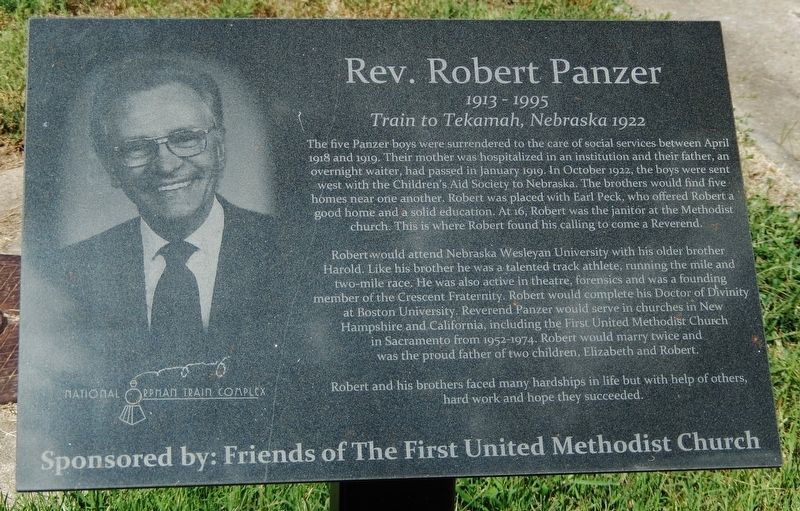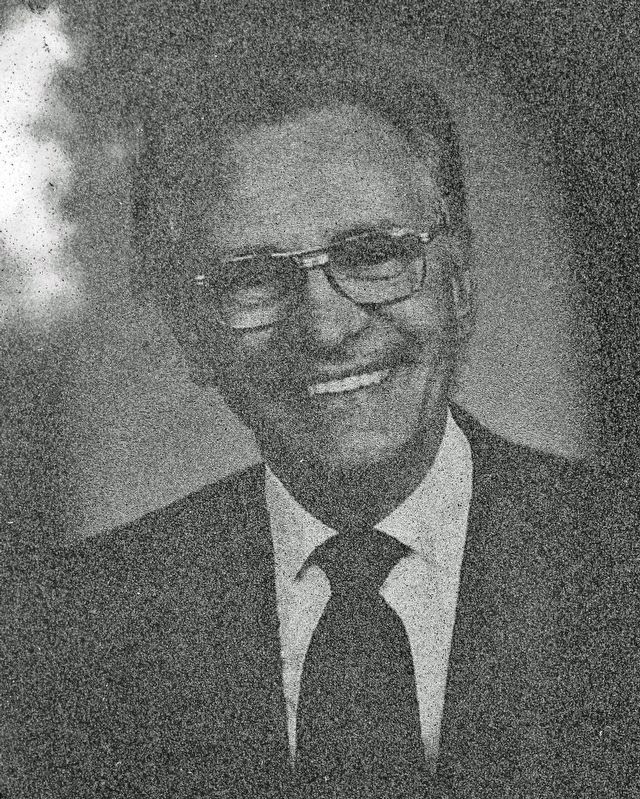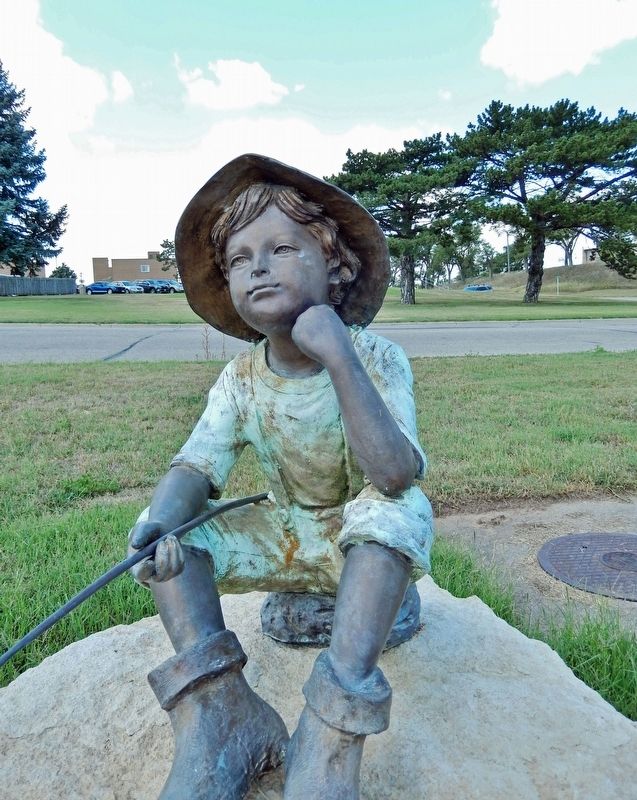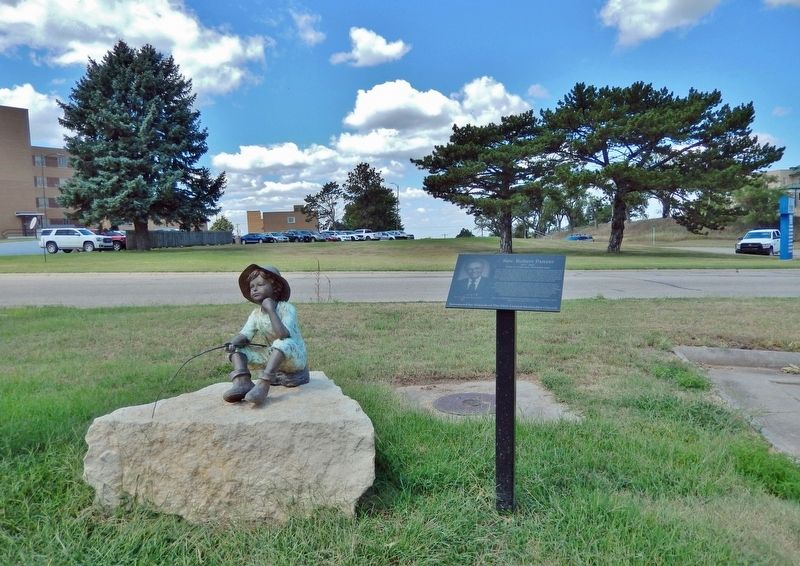Concordia in Cloud County, Kansas — The American Midwest (Upper Plains)
Rev. Robert Panzer
1913-1995
— Train to Tekamah, Nebraska 1922 —
The five Panzer boys were surrendered to the care of the social services between April 1918 and 1919. Their mother was hospitalized in an institution and their father, an overnight waiter, had passed in January 1919. In October 1922, the boys were sent west with the Children’s Aid Society to Nebraska. The brothers would find five homes near one another. Robert was placed with Earl Peck, who offered Robert a good home and a solid education. At 16, Robert was the janitor at the Methodist church. This is where Robert found his calling to become a Reverend.
Robert would attend Nebraska Wesleyan University with his older brother Harold. Like his brother he was a talented track athlete, running the mile and two-mile race. He was also active in theatre, forensics and was a founding member of the Crescent Fraternity. Robert would complete his Doctor of Divinity at Boston University. Reverend Panzer would serve in churches in New Hampshire and California, including the First United Methodist Church in Sacramento from 1952-1974. Robert would marry twice and was the proud father of two children, Elizabeth and Robert.
Robert and his brothers faced many hardships in life but with the help of others, hard work and hope they succeeded.
Erected by National Orphan Train Complex; and Friends of The First United Methodist Church.
Topics. This historical marker is listed in these topic lists: Charity & Public Work • Churches & Religion • Education • Railroads & Streetcars. A significant historical month for this entry is October 1922.
Location. 39° 33.963′ N, 97° 40.342′ W. Marker is in Concordia, Kansas, in Cloud County. Marker is on Highland Drive just south of West 11th Street, on the left when traveling south. Marker and sculpture are located on the west side of the First United Methodist Church parking lot. Touch for map. Marker is at or near this postal address: 740 West 11th Street, Concordia KS 66901, United States of America. Touch for directions.
Other nearby markers. At least 8 other markers are within walking distance of this marker. William James Family (approx. 0.3 miles away); Alberta Cole / Roberta Work Miller Slifer (approx. half a mile away); Kansas Orphan Riders (approx. half a mile away); Cloud County War Memorial (approx. 0.6 miles away); Brown Grand Theatre (approx. 0.6 miles away); Mary Mullen Leikam Kraus Jacobs Hardt (approx. 0.6 miles away); Genevieve Hunt / Sister Roberta Dreiling (approx. 0.6 miles away); Gertrude Vale / Sister Eva Marie Vale (approx. 0.6 miles away). Touch for a list and map of all markers in Concordia.
Related markers. Click here for a list of markers that are related to this marker. Orphan Train Movement
Also see . . .
1. Rev Robert Allan Panzer (Find A Grave).
El Camino Memorial Park, San Diego, San Diego County, California, USA(Submitted on December 22, 2022, by Cosmos Mariner of Cape Canaveral, Florida.)
2. An Orphan Train Rider’s Story.
From approximately 1854 to 1929, the “Greatest American Migration” took place. Upward of 250,000 children were displaced from their homes on the East Coast, mostly from New York City, and sent to every state in the union, but mostly to the Midwest, in what has come to be called the orphan train movement. It displaced more children than any other movement in world history. The children were homeless, vagrant children or were from the local orphanages. They were sent westward by primarily the Children’s Aid Society, through the work of the Rev. Charles Loring Brace, or by the New York Foundling Hospital. Some of the children found good, loving foster homes. Others entered abusive environments or were used as farm or domestic labor.(Submitted on December 22, 2022, by Cosmos Mariner of Cape Canaveral, Florida.)
3. The Orphan Trains.
The story of this ambitious and finally controversial effort to rescue poor and homeless children begins in the 1850s, when thousands of children roamed the streets of New York in search of money, food and shelter — prey to disease and crime. Many sold matches, rags, or newspapers to survive.(Submitted on December 22, 2022, by Cosmos Mariner of Cape Canaveral, Florida.)
Credits. This page was last revised on December 24, 2022. It was originally submitted on December 20, 2022, by Cosmos Mariner of Cape Canaveral, Florida. This page has been viewed 84 times since then and 20 times this year. Photos: 1, 2, 3, 4. submitted on December 22, 2022, by Cosmos Mariner of Cape Canaveral, Florida.



